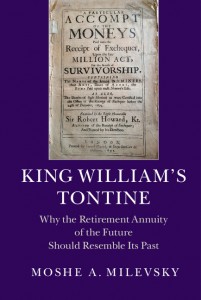
By Moshe A. Milevsky
Special to the Financial Independence Hub
Here is a non-surprising fact. Most retired individuals do not choose to voluntarily annuitize their accumulated wealth or savings at retirement. They prefer the lump sum. This has been christened by financial economists: “the annuity puzzle” and has been the topic of Ph.D. theses for decades. I am guilty of supervising a few of these myself.
Sadly, life annuities are relatively unpopular – especially compared to stocks and bonds — in a large part of the world and simply unavailable in most others. Indeed, the few jurisdictions and countries in which there is a sizeable market for annuity products – such as Canada or the U.S. — it is often driven by tax-advantaged treatment and/or government “nudging and defaults” as opposed to an intrinsic consumer appreciation for longevity insurance. Like most insurance products, they are ‘sold’ but rarely purchased.
Could the past hold the key to Longevity Insurance?
Well, I believe one of the reasons for the lack of interest or disdain for life annuity products – while the demand for fixed income bonds is undiminished — is the opacity, public confusion and limited selection of mortality credits; which are the raison d’etre for annuitization. Indeed, there are hundreds of ways to save (i.e. accumulate) money for retirement – instruments such as stocks, bonds, mutual funds and ETFs – but there are precious few choices for dissaving (i.e. de-accumulating) and generating income in retirement.
So, here is my pitch. Perhaps a resolution of the so-called retirement “annuity puzzle” is to design products that make it easier for buyers to determine exactly what they are getting in exchange for giving-up liquidity and sacrificing some bequest and legacy value. In fact, these sorts of products that I have in mind were available and quite popular centuries ago. It might sound odd, but when it comes to finance and insurance products, I look to the past for inspiration.
King William’s Tontine
 Here is the story. In the year 1693 – back in England — the government of King William III, previously known as William of Orange, needed vast sums of money to finance his war against King Louis XIV of France. This was actually year or so before the Bank of England was established primarily to finance wars, and parliament was in the early stages of experimenting with new and untested borrowing schemes.
Here is the story. In the year 1693 – back in England — the government of King William III, previously known as William of Orange, needed vast sums of money to finance his war against King Louis XIV of France. This was actually year or so before the Bank of England was established primarily to finance wars, and parliament was in the early stages of experimenting with new and untested borrowing schemes.
Anyway, parliament decided to borrow the money — in increments of £100 units — from wealthy investors in London and abroad. Today we might call what they issued a government bond. In fact, it operated in a way that was quite similar to modern day debt instruments, except for one very small but rather chilling feature.
Investors or buyers would receive annual coupons of 7%, paid semi-annually by the Exchequer. Year after year the bond paid £7 to investors who were willing to ‘lend’ King William and his government the £100 in the year 1693.
But – and here is the key – if and when the investor or bond buyer passed away and died, he or she would not be able to bequeath or bestow the investment to a family member or loved one. The investment benefit would extinguish itself upon death. Instead the forfeited 7% coupons would go to those still living. To paraphrase Mr. Goldfinger in the famous movie named after its main villain, the ‘bond’ was ‘expected to die’ with the master.
This ladies and gentlemen is a tontine (rhymes with Drunk Queen) scheme.
Tontine: The dead subsidize the living
If this sort of arrangement seems odd and morbid – and you wonder why anyone in the world would buy such an odd thing – think about it carefully from the perspective of those who didn’t have the misfortune to die young. The longer they lived, the more income and cash they received, that is other people’s money. The coupons increased with age; which actually served as an inflation hedge of sorts. After all, living to a grand old age can be rather expensive today or in the 18th century. In the case of King William’s Tontine – as this scheme was known — the oldest known survivor lived to the amazing age of 100. She earned thousands of pounds per year, which is quite the pension and envy of many retirees today.
Over time this tontine scheme and many others were superseded by ‘the sturdy bond’ we use today and insurance companies took over the business of selling ‘retirement life annuities’, which are based on the same principal.
The pension and income annuity we all know today is a distant relative of the tontine. Alas, a number of countries banned these tontines outright in the last 19th century, partially under the misguided fear that some of the longer living investors might try to kill each other. To my knowledge, this never happened.
Time to resurrect tontines?
Sadly though, today, tontines are more likely to appear as a plot in a fantastical murder mystery or as punch line of a joke, rather than in serious discussions about government financing. But in fact, there is a strong argument to be made that these sorts of tontines should be resurrected from the dead and re-introduced in the 21st century. I think it is time to look to history for new (or old) ideas.
In sum — and without getting too technical here — my simple back-of-the-envelope calculations indicate that if retirees were willing to allow for a just a little bit of “demographic variability” around their income, they could increase their expected retirement income by 10% to 15% without taking on any stock market (or any other) risks. Stated differently, your Findependence Day might arrive a few years earlier.
Intrigued? More questions? Read the book: KING WILLIAM’S TONTINE: Why the Retirement Annuity of the Future Should Resemble its Past (Cambridge University Press, May 2015)
Moshe A. Milevsky is a tenured professor at the Schulich School of Business at York University and Executive Director of the IFID Centre at the Fields Institute for Research in Mathematical Sciences in Toronto. He has published 12 books, over 60 peer-reviewed papers, hundreds of newspaper and magazine articles and serves on the editorial & advisory board of numerous scholarly journals. He has written for the Wall Street Journal, the Globe & Mail, the National Post and Research Magazine. Moshe has also delivered more than 1,000 lectures and keynote presentations to audiences around the world. He was recently selected as one of the 35 most influential people in the financial industry by Investment Advisor magazine. In addition to being the author of King William’s Tontine, he is also the co-author (with Alexandra Macqueen) of PENSIONIZE™ YOUR NEST EGG (2nd edition, WILEY, April 2015).


Intriguing! How would the coupon % be determined – based on current rates I would guess there would be very little interest. Could these be laddered ? and/or have sliding rates? Who would administer the scheme and what slice would they get? – many questions